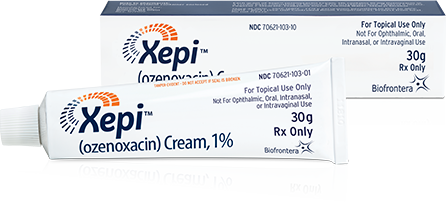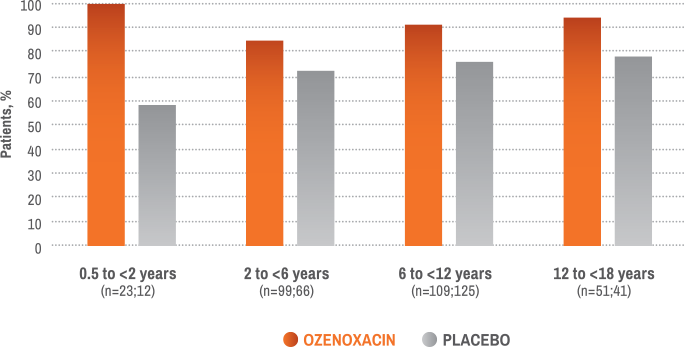
XEPI® (ozenoxacin) CREAM, 1% MAKES S. AUREUS AND
S. PYOGENES DISAPPEAR FAST1-3
CLINICAL SUCCESS WAS SEEN FOLLOWING 5 DAYS OF TREATMENT1
- Xepi® met its primary endpoint of clinical success by days 6-7 (including 5 days of twice-daily treatment)1,2
- Significant clinical improvement was shown as early as 2 to 3 days after start of treatment3

XEPI® ACHIEVED A STATISTICALLY SIGNIFICANT GREATER IMPROVEMENT COMPARED TO PLACEBO AT THE END OF 5 DAYS OF THERAPY1
Clinical success at end of therapy in trial 1 and trial 2 in subjects with S. aureus or S. pyogenes (days 6 to 7)1
Xepi® was studied in two multicenter, randomized, parallel-group, double-blind, superiority clinical, placebo-controlled clinical trials comparing Xepi® Cream with placebo cream twice daily for 5 days. Seven hundred twenty-three (723) subjects 2 months of age and older with an affected body surface area of up to 100 cm2 were randomized to Xepi® or placebo (affected body surface did not exceed 2% for subjects aged 2 months to 11 years).1-3
CLINICAL SUCCESS DEFINED
Overall clinical success was defined as no need for additional antimicrobial therapy of the baseline affected area(s) and absence/reduction in clinical signs and symptoms assessed at the end of therapy (days 6-7), as follows: absence of exudates/pus, crusting, tissue warmth, and pain; and erythema/inflammation, tissue edema, and itching assessed as less than mild in Trial 1; and absence of blistering, exudates/pus, crusting, and itching/pain, and mild or improved erythema/inflammation in Trial 2.1
Adverse reactions (rosacea and seborrheic dermatitis) were reported in 1 adult patient treated with Xepi®.1,3
DIFFERENCES IN CLINICAL SUCCESS RATES BETWEEN XEPI® COMPARED TO PLACEBO ASSESSED AT 6 TO 7 DAYS IN PEDIATRIC PATIENTS STRATIFIED BY AGE4,†
Patients were treated twice a day for 5 days

†The clinical success rate was 100% in the 2 to <6 months age group after ozenoxacin treatment (n=5); this was comparable to placebo (n=3).4
- Data for pediatric patients with impetigo (N=534) who participated in a phase 1 study (n=38) and two multicenter, randomized, placebo-controlled phase 3 clinical trials of ozenoxacin (1%) cream analyzed by age group. Although the main aim of the phase 1 study was to evaluate the systemic absorption of ozenoxacin in patients with impetigo, patients were also assessed for safety, tolerability, and clinical responsiveness4
- Clinical success was defined as cure (total SIRS score of 0 for exudates/pus, crusting, tissue warmth and pain, and ≤1 for each of erythema/inflammation, tissue or edema and itching; and no requirement for additional antimicrobial therapy of baseline affected areas) or as improvement (SIRS score decreased by >10% compared to baseline, and not fulfilling SIRS score criteria for a cure; a patient showing clinical improvement at the end of therapy could continue treatment with another antimicrobial at the discretion of the investigator)4
- Due to the selection of pediatric patients for re-analysis and consequent decrease in statistical power relative to the entire patient population per study, comparisons by age group were analyzed descriptively4
SIRS, systemic inflammatory response syndrome.
INDICATION AND IMPORTANT SAFETY INFORMATION
INDICATION AND USAGE
Xepi® (ozenoxacin) Cream, 1% is indicated for the topical treatment of impetigo due to Staphylococcus aureus or Streptococcus pyogenes in adult and pediatric patients 2 months of age and older.
Apply a thin layer of Xepi® topically to the affected area twice daily for 5 days. Affected area may be up to 100 cm2 in adult and pediatric patients 12 years of age and older or 2% of the total body surface area and not exceeding 100 cm2 in pediatric patients less than 12 years of age.
IMPORTANT SAFETY INFORMATION
Xepi®, containing 1% ozenoxacin, is for topical use only. Not for ophthalmic, oral, intranasal or intravaginal use.
Apply a thin layer of Xepi® topically to the affected area twice daily for 5 days. Affected area may be up to 100 cm2 in adult and pediatric patients 12 years of age and older or 2% of the total body surface area and not exceeding 100 cm2 in pediatric patients less than 12 years of age.
Potential for Microbial Overgrowth: Prolonged use of Xepi® may result in overgrowth of nonsusceptible bacteria and fungi. If such infections occur, discontinue use and institute alternative therapy.
Adverse reactions (rosacea and seborrheic dermatitis) were reported in 1 adult patient treated with Xepi®.
There are no available data on the use of Xepi® in pregnant women to inform a drug associated risk. No data are available regarding the presence of ozenoxacin in human milk, and the effects of ozenoxacin on the breastfed infant or on milk production.
The safety and effectiveness of Xepi® in the treatment of impetigo have been established in pediatric patients 2 months to 17 years of age. The safety profile of Xepi® in pediatric patients 2 months and older was similar to that of adults.
The safety and effectiveness of Xepi® in pediatric patients younger than 2 months of age have not been established.
Please read the US Full Prescribing Information for Xepi® available at https://www.xepicream.com/PI.
You are encouraged to report side effects of Xepi®. Please contact Biofrontera Inc. at 1-844-829-7434 or FDA at 1-800-332-1088 or www.fda.gov/medwatch.
References: 1. Xepi® [package insert]. Woburn, MA: Biofrontera, Inc.; 2020. 2. Gropper S, Albareda N, Chelius K, et al. Ozenoxacin 1% cream in the treatment of impetigo: a multicenter, randomized, placebo- and retapamulin-controlled clinical trial. Future Microbiol. 2014;9(9):1013-1023. 3. Rosen T, Albareda N, Rosenberg N, et al. Efficacy and safety of ozenoxacin cream for treatment of adult and pediatric patients with impetigo: a randomized clinical trial. JAMA Dermatol. 2018;154(7):806-813. 4. Herbert AA, Rosen T, López NA, et al. Safety and efficacy profile of ozenoxacin 1% cream in pediatric patients with impetigo. Int J Womens Dermatol. 2020;6(2):109-115.